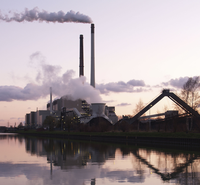
Emissions trading is a market-oriented approach to controlling pollution by providing economic incentives for reducing the emissions of pollutants.[1] The concept is also known as cap and trade (CAT) or emissions trading scheme (ETS). One prominent example is carbon emission trading for CO2 and other greenhouse gases which is a tool for climate change mitigation. Other schemes include sulfur dioxide and other pollutants.
In an emissions trading scheme, a central authority or governmental body allocates or sells a limited number (a "cap") of permits that allow a discharge of a specific quantity of a specific pollutant over a set time period.[2] Polluters are required to hold permits in amount equal to their emissions. Polluters that want to increase their emissions must buy permits from others willing to sell them.[1][3][4][5][6]
Emissions trading is a type of flexible environmental regulation[7] that allows organizations and markets to decide how best to meet policy targets. This is in contrast to command-and-control environmental regulations such as best available technology (BAT) standards and government subsidies.
- ^ a b Stavins, Robert N. (November 2001). "Experience with Market-Based Environmental Policy Instruments" (PDF). Discussion Paper 01-58. Washington, D.C.: Resources for the Future. Retrieved 2010-05-20.
Market-based instruments are regulations that encourage behavior through market signals rather than through explicit directives regarding pollution control levels or methods
- ^ Cite error: The named reference
glossarywas invoked but never defined (see the help page). - ^ "Allowance Trading". U.S. Environment Protection Agency. Archived from the original on November 9, 2014. Retrieved Oct 21, 2014.
- ^ Judson Jaffe; Matthew Ranson; Robert N. Stavins (2009). "Linking Tradable Permit Systems: A Key Element of Emerging International Climate Policy Architecture". Ecology Law Quarterly. 36 (789). Retrieved 2023-08-25.
- ^ Tietenberg, Tom (2003). "The Tradable-Permits Approach to Protecting the Commons: Lessons for Climate Change". Oxford Review of Economic Policy. 19 (3): 400–419. doi:10.1093/oxrep/19.3.400.
- ^ Stavins, Robert N. (1 November 2001). "Experience with Market-Based Environmental Policy Instruments". Discussion Paper 01-58. Washington, D.C.: Elsevier. pp. 355–435. Archived (PDF) from the original on 1 May 2011. Retrieved 2 January 2024.
- ^ Teeter, Preston; Sandberg, Jorgen (2016). "Constraining or Enabling Green Capability Development? How Policy Uncertainty Affects Organizational Responses to Flexible Environmental Regulations" (PDF). British Journal of Management. 28 (4): 649–665. doi:10.1111/1467-8551.12188. S2CID 157986703. Archived (PDF) from the original on 2020-05-06. Retrieved 2020-06-06.